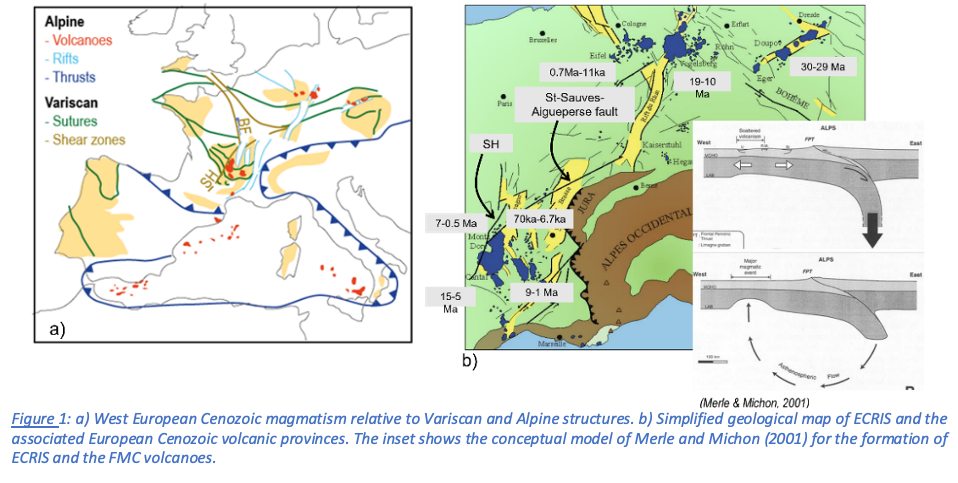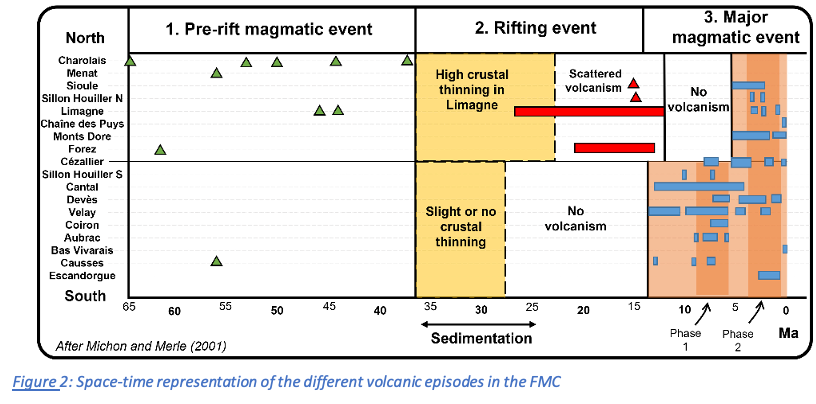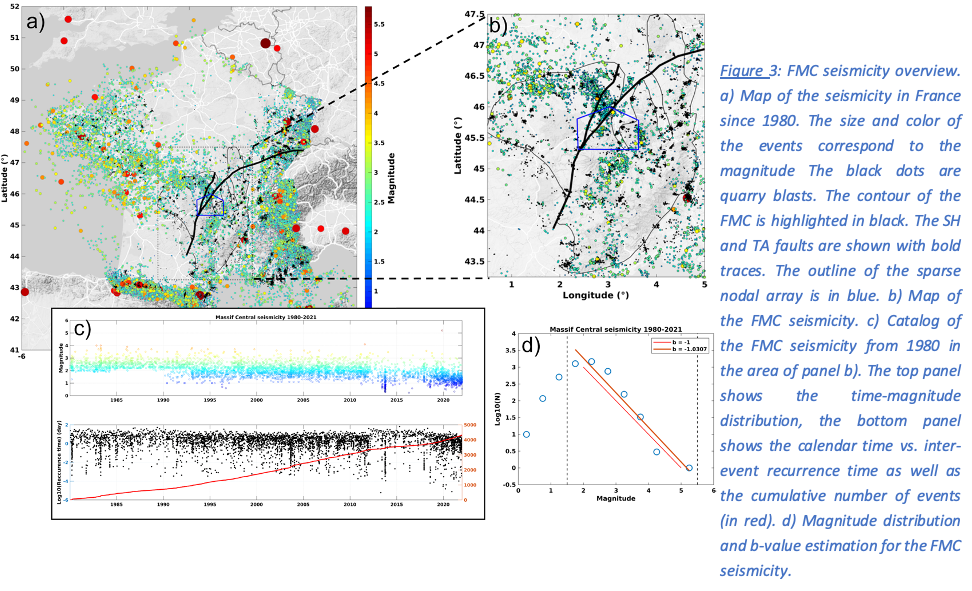State of the art
(at project start)
The FMC (Figure 1) is the largest zone of exposed Variscan basement in Western Europe, and is key to understanding the growth of the continental crust at the Proterozoic-Phanerozoic transition and the Variscan orogeny. The FMC geology also recorded the Alpine cycle, the opening of rifts before the Late Eocene, and the most significant intraplate volcanic activity in Western Europe. Understanding this Mesozoic-Cenozoic activity has implications for assessing seismic and volcanic risks and exploring and exploiting geothermal, water, and mineral resources.
Seismological and thermo-mechanical studies (Babuška et al., 2002 ; Barruol & Granet, 2002 ; Sobolev et al., 1997) combined with xenolith data (Lenoir et al., 2000), suggested that the FMC is divided into several crustal or lithospheric domains with different tectonic histories expressed by Late Variscan strike-slip faults such as the Sillon Houiller (SH) and the St-Sauves-Aigueperse fault (Figure 1). The SH acted as a transfer zone between the Limousin and the eastern part of the FMC during late- orogenic Variscan N-S extension (Vanderhaeghe et al., 2020) and still represents a major lithospheric structure that constrained volcanism to the East of the FMC before and after the Oligocene rifting periods.
The FMC as a major manifestation of European intraplate volcanism has been influenced by the formation of the European Cenozoic Rift System (ECRIS). It is debated whether the ECRIS is solely related to the Alpine subduction through a slab-pull effect (Figure 1) or whether it also interacted with a mantle plume (Granet et al., 1995) to generate the volcanic provinces. A "primary" (Courtillot et al., 2003) hot-spot plume hypothesis is unlikely because the ECRIS crustal extension is too important to be explained solely by a mantle plume. The petrological estimation of the depth of magma sources suggests that they are mainly located at the base of the lithosphere. In addition, the shift of volcanic activity in time and space does not conform with the drift pattern of the European plate over a system of deep-seated, stationary mantle plumes. Nevertheless, the "baby-plume" theory, stating that the European intraplate volcanism was caused by small-scale plumes emanating from the upper mantle, remains one of the possible hypotheses (Granet et al., 1995).
The FMC is the largest magmatic province of the ECRIS that was formed during three episodes : the pre-rift, the syn-rift, and the major post-rift events (Michon & Merle, 2001 ; Figure 2). The latter erupted up to 1500 km3 of magma. During the first phase of the major magmatic event (9-6.3 Ma) the largest magmatic provinces of the FMC (Cantal, Aubrac, Velay, and Coiron) were formed. The second phase of this event (3.5-0.23 Ma) produced new magmatic provinces (Mont-Dore and Devès) and reactivated old ones in the Limagne graben and Velay. The most recent volcanism (0.04–0.007 Ma) is located in the Bas-Vivarais and the Chaîne des Puys (CdP), with the last eruptions dated at 6700 years BP at Lake Pavin (Sime-Ngando et al., 2016). While the volcanism is essentially fissural, two large stratovolcanoes are also present : the Cantal and the Monts Dore-Sancy. Significant differences are observed between the North and the South of the FMC. While the northern part presents volcanic and sedimentary alignments essentially north-south, the southern part reveals alignments oriented NW- SE. This north-south heterogeneity is also found in the diachronism of volcanism (Figure 2) and clear differences in xenoliths compositions (refractory north of the Monts Dore but fertile south of it ; Lenoir et al., 2000 ; Puziewicz et al., 2020). This boundary is also marked by different orientations of seismic anisotropy (Babuška et al., 2002), suggesting the northern and southern parts of the volcanic province could correspond to different lithospheric blocks inherited from the Variscan orogeny and differently affected by Cenozoic thermal resetting.
Ongoing gas emissions of mantle origin escaping from bubbling springs and mofettes at several sites in the FMC are evidences that these volcanic provinces are still active and that direct conduits accommodating fluid circulation from the upper mantle to the surface are possible (Bräuer et al., 2017). In similar geological contexts, both Eifel (Germany) and Eger (Czech Republic) volcanic regions (Figure 1b) show similar patterns of subcontinental lithospheric mantle degassing at the surface. The many hot springs across the volcanic province, with temperatures at depth estimated at 150-200°C, are also proof that heat sources are still present in the upper crust (Duwiquet et al., 2019). Finally, recent (unpublished) magneto-telluric (MT) measurements performed in the area of the Lake Pavin by D. Laporte’s team at LMV (Clermont-Ferrand), show clear conductive anomalies below the youngest edifices, possibly related to hot and partially molten magma pockets.
The FMC is characterized by a relatively low seismic activity (Mazabraud et al., 2005) and acts as a transfer zone between more seismically active regions : the Armorican Massif in the North-West, the Pyrenees in the South, and the Alps in the East (Figure 3a). Some areas exhibit mainly swarm-type activity (Mont-Dore, St-Flour graben, Ambert basin) with sequences of comparable magnitude, which are concentrated in time (Figure 3b-c). Elsewhere, earthquakes are isolated in time and space. Focal mechanisms show that the present tectonic regime is a WSW-ENE extension (Dorel et al., 1995 ; Mazabraud et al., 2005). Magnitude >5, and possibly stronger events have occurred in recent times, as demonstrated by historical earthquakes around Clermont-Ferrand in 1477 and 1490 (Mw 6.1) and in 1833 (Mw 5), tentatively located on the Limagne fault (Dorel et al., 1995 ; Chassiot et al., 2016). While no seismicity clearly related to volcanic processes has been reported in the FMC to date, considering the young age of some volcanoes and volcanic earthquakes observed in other ECRIS volcanic provinces such as Eifel (Hensch et al., 2019) a seismo-volcanic reactivation cannot be excluded. Therefore, the volcanic and seismic hazard in the region are still relevant and need to be evaluated and studied.
The knowledge of the FMC geology and tectonics, despite the legacy geophysical studies and the geological campaigns of the 1980s and 1990s, is incomplete, and its improvement requires an effort of harmonization of information. The existing geophysical coverage is highly fragmentary. The FMC has been studied as a whole only in the 1970s through seismic refraction profiles (Perrier & Ruegg, 1973) leading to Moho and lithosphere models of the northern part of the FMC. These studies demonstrated the fundamental role of the SH but had insufficient resolution to determine its characteristics and scale (crustal and/or lithospheric). In Limousin, they provided constraints on the crustal structure, imaged by two deep seismic reflection profiles combined with gravimetry. In the early 1990s, a temporary seismic array was centered on the Auvergne volcanoes ; this project remains the last large-scale seismology project in the region (Granet et al., 1995). The tomographic images have shed light on the structure of the upper mantle in relation to the Cenozoic volcanism, but their limited resolution and coverage resulted in strong uncertainties in their interpretations.
The legacy geophysical data have shown that the FMC is a first-order geological object that deserves a significant geophysical imaging program to complete the surface mapping and constrain its crustal and lithospheric structure. The FMC constitutes an ideal federating site covering many disciplines of geosciences and allowing to address major fundamental scientific questions related to the processes of continental breakup (passive vs. active rifting mode), the nature, origin, and impact of hotspots and mantle plumes on continental crust, the origin of intraplate volcanism and the influence of pre-existing structures on the evolution of magmatic provinces. Due to its rich geological and volcano-magmatic processes, the FMC also contains various under-exploited and under-developed mineral and geothermal resources. A broader societal impact of this project will be to provide a general geological framework to better assess these resources in the important socio-economical context of energy transition.
Updated on 11 janvier 2024






